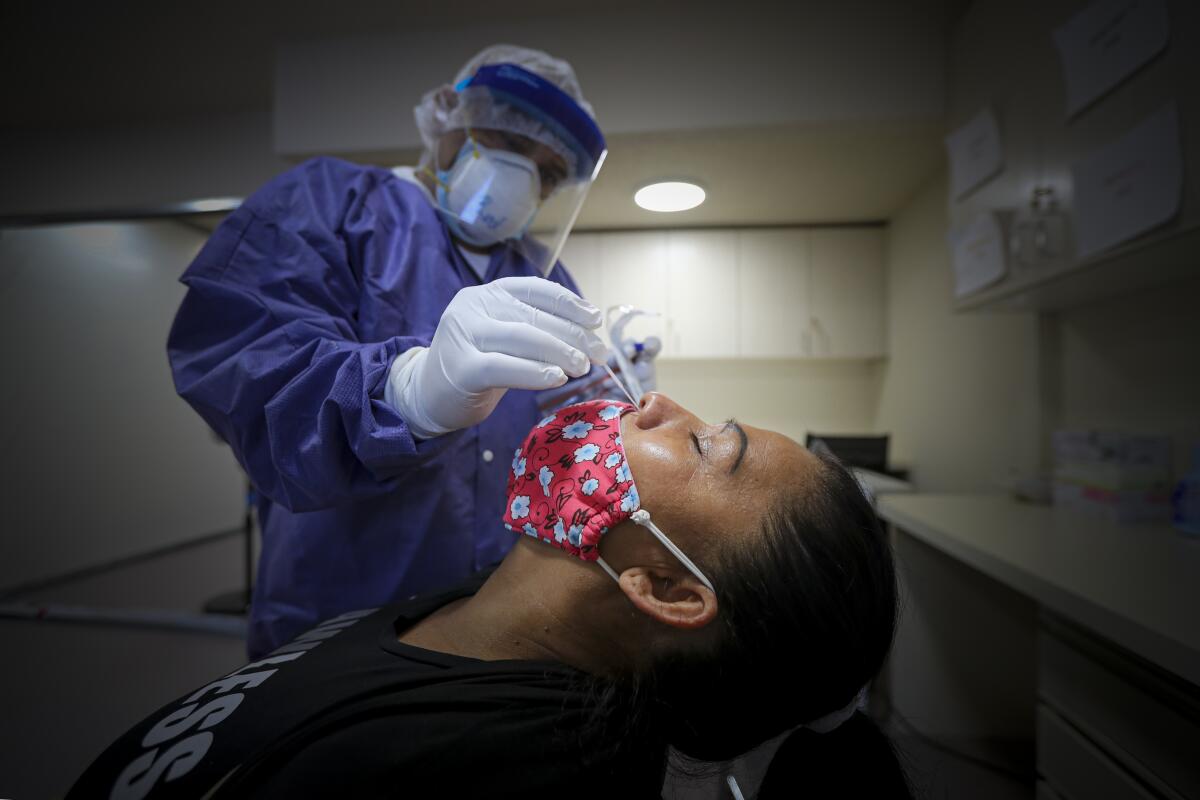Coronavirus surge slowing in California, but don’t expect a repeat of reopening fever

There are growing glimmers of hope that California’s surge in coronavirus cases could be peaking — but don’t expect the pandemic-shattered economy to share much of this progress in the short term.
A Los Angeles Times analysis found that California has now experienced its first weekly reduction in new confirmed coronavirus cases for the first time in 12 weeks. For the seven-day period that ended Sunday, California reported 59,697 new coronavirus cases, a drop of 9% from the previous week of 65,634 cases, which was a pandemic record.
If the trends continue, it would mark a turning point after weeks of record hospitalizations that began in mid-June, the result of California starting to rapidly reopen the economy in May.
Allowing many businesses to reopen their doors in May and June seemed like a moment of triumph, with California celebrating a seeming miracle in avoiding the huge death tolls of hot spots like New York and New Jersey.
But the subsequent summertime spikes in disease have humbled the Golden State, and epidemiologists and other public health experts said the only way to prevent surges is to learn from past failure. That means continued restrictions of public movements and better education and outreach about how to prevent new outbreaks.
It also means setting better and narrower priorities — such as putting an emphasis on schools reopening over allowing bars and indoor dining rooms to resume operations. They were shut down again in late June and early July.
“We have learned how dangerous indoor environments are for transmission,” said Dr. Kirsten Bibbins-Domingo, chair of UC San Francisco’s Department of Epidemiology and Biostatistics. “Frankly, those things like indoor dining and bars and restaurants are those types of very discretionary things that I don’t think we can take a risk on at a time when we’re talking about” schools unable to be opened.
The surge in California cases has been blamed on several factors, including a failure to follow new disease control measures at workplaces, leading to the rapid spread of disease among lower-income and essential workers in factories, agriculture and other businesses, as well as people getting back to old habits like parties and summer gatherings.
“We didn’t expect people to become complacent as they have, which provides more opportunities for transmission,” said Dr. Robert Kim-Farley, medical epidemiologist and infectious-diseases expert at the UCLA Fielding School of Public Health. That resulted in reclosing bars and limiting restaurant service to outdoor dining or takeout, and “we end up on a roller coaster ride.”
On Monday, officials vowed to do things differently this time as they cited progress in efforts to slow the spread of COVID-19.
“We’re cautiously optimistic that we’re getting back on track to slowing the spread of COVID-19,” said Barbara Ferrer, L.A. County’s public health director. L.A. County reported an average of 2,594 new cases daily over the past week on Sunday, down from its peak of 3,284 on July 17, which Ferrer said is “still really high, but it does show progress.”
Ferrer said the improvements mean that “simply put, closing the bars worked. It also worked to limit indoor dining at restaurants and to move the operations of various businesses and institutions outdoors.” In addition, Ferrer credited Angelenos with increasingly wearing face masks and avoiding gatherings and parties.
Gov. Gavin Newsom said it would take a few weeks before knowing for certain whether California was on an improving path.
“We can quickly find ourselves back to where we were just a few weeks ago, a month ago, with significant increases if we do not maintain our vigilance,” Newsom said Monday. “Until we have a vaccine, we are going to be living with this virus.”
One of the things Newsom said would be different this time is looking for not only consistent stabilization of key pandemic numbers — as occurred before the first reopening — but consistent declines as well. And Newsom said he’s realized that there needs to be greater efforts on educating the public about how to reduce the spread of disease, and that will be “foundational in terms of any subsequent efforts to reopen.”
In the first reopening, too many Californians resumed gatherings and did not wear masks, he said, planting the seeds of the second resurgence of disease.
“Let’s not relive that experience again,” Newsom said.
Dr. Peter Chin-Hong, professor of medicine and an infectious disease specialist at UC San Francisco, warned that California is now at a higher plateau of disease than it was when the first surge seemed to ease. And failing to reduce disease transmission in hot spots can easily help ignite a renewed surge of cases.
“The plateau wasn’t where we were in March or early April. It’s at a higher level,” Chin-Hong said. “When you’re at that high point, you can go up very easily to then tip over into not having hospital resources. ... The risk is much higher.”
Kim-Farley, of UCLA, said California is still in its first wave of the disease, but its second plateau. “We can’t expect to reopen again soon; we have to be at least at the level of the first plateau and dropping before we can further reopen,” Kim-Farley said.
Most California counties have much to do before they can get new case rates low enough to begin contemplating business reopenings. One of the state’s criteria is having counties have fewer than 100 new cases per 100,000 residents over a two-week period; as of Tuesday morning, San Bernardino County has a rate of 437; L.A. County, 344; Riverside County, 342; Ventura County, 251; Orange County, 248; and San Diego County, 184.
Many counties in the Central Valley are hard hit; Kern County is the worst in the state, with a rate of 1,293 new cases per 100,000 residents in the last two weeks; rural counties are hit hard, too, with Imperial County reporting a rate of 467 and Mono County, home to Mammoth Lakes, at 430.
Reductions in cases were seen regionally throughout the state. The five-county Southern California area — L.A., Orange, Riverside, San Bernardino and Ventura counties — has now experienced two consecutive weeks of falling weekly case numbers, and recorded 30,662 last week, down 16% from its weekly high two weeks ago, when 36,637 cases were reported.
San Diego County has also experienced two consecutive weeks of declines in cases, recording 2,899 cases last week, down 23% from the number two weeks ago. The nine-county San Francisco Bay Area reported 6,661 cases last week, a 3% drop from its previous week; the seven-county Sacramento region, 1,787 cases, a 33% drop.
The eight-county San Joaquin Valley experienced 14,295 cases last week, an 11% decrease from the previous week’s total of 15,874. But last week’s number was still much higher than it was three weeks ago, when 8,837 cases were recorded.
The rate at which coronavirus test results are positive is also declining. It was above 8% in early July; as of Monday, the statewide seven-day positive test rate fell to 6.1%. In L.A. County, the positive test rate has been stable, between 8% and 8.8% over the past month.
Statewide hospitalizations also stopped its relentless climb. California experienced a daily average of 6,632 people in hospitals with confirmed coronavirus infections last week, a 5% drop from the previous week, when an average of 6,969 people were hospitalized.
Deaths, however, are a lagging indicator of the pandemic, and continue to climb to record levels. Last week, 945 Californians died from COVID-19, the worst such weekly number in the pandemic and a 9% increase from the previous week. An average of 135 Californians a day died last week from the pandemic.
There remain challenges.
The case numbers in L.A. County alone are so overwhelming — cumulatively more than 193,000 — that they dwarf the experience the entire nation of South Korea faced in its pandemic, which has recorded fewer than 15,000 cases.
South Korea, with a population of 51 million people, never saw more than 1,000 positive cases in a single day, Ferrer said, while L.A. County, with a population of 10 million, routinely experiences double or triple that volume daily, a pace that has persisted for more than a month.
Relying on contact tracing — the process by which county health officials reach out to newly infected people and try to identify close contacts and get them to quarantine — is proving to not be as effective as once hoped, given the astonishing number of cases. In nearly one-third of cases, newly infected people in L.A. County either refused to talk to a county disease investigator or they could not be found. Officials are now offering $20 gift cards to encourage people to complete the interview.
Healthcare workers statewide are increasingly getting infected; an average of 374 healthcare workers were getting infected daily statewide last week; that’s up 84% over the past month.
State Alcoholic Beverage Control and county health officials have launched an investigation over reports of a large indoor party allegedly attended by L.A. County sheriff’s personnel at a Hollywood bar. The Sheriff’s Department on Saturday denied it hosted the event and said it is investigating.
“There is really zero tolerance for having indoor parties,” Ferrer said.
Even healthcare professionals can become complacent. At one hospital, officials realized it was communal dining among nurses or physicians that was spreading the coronavirus among coworkers. “Social events have gone away, basically,” Dr. Carlos del Rio, professor at Emory University School of Medicine, said at a recent UC San Francisco webinar.
Times staff writer James Queally contributed to this report.
More to Read
Sign up for Essential California
The most important California stories and recommendations in your inbox every morning.
You may occasionally receive promotional content from the Los Angeles Times.












